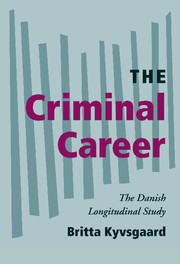1 - The Career Concept in Criminological Research
Published online by Cambridge University Press: 09 July 2009
Summary
the term “career,” which is of French origin, originally meant carriage road or racing track. Today it is primarily used to connote profession or occupation, especially that which carries the possibility of promotion. The term thus concerns either a profession or the progress in a person's working or professional life.
Sociologically, the career concept has been used in organizational analyses of structures and changes, in studies related to individual career choices and strategies, and in works which combine the structural and subjective perspectives (Evetts, 1992).
Sociologist Everett C. Hughes is said to have introduced the career concept to the Chicago School (Kempf, 1987). For Hughes, the career is “the moving perspective in which the person sees his life as a whole and interprets the meaning of his various attributes, actions, and the things which happen to him” (Hughes, 1937, pp. 409–10). The career thus becomes the subjective interpretation of one's relation to and placement in society. Interpretations change over time just as a subject's life does, and encompass not only paid work or professional activities, but all the endeavors a person is occupied with.
The term “career” was, however, used in criminological studies at the Chicago School before Hughes defined and described it as cited above. In 1930 and 1931 Clifford R. Shaw published, respectively, The Jack-Roller and The Natural History of a Delinquent Career, both of which used the term “career” to describe the criminal histories of single individuals derived from case studies.
- Type
- Chapter
- Information
- The Criminal CareerThe Danish Longitudinal Study, pp. 1 - 4Publisher: Cambridge University PressPrint publication year: 2002

